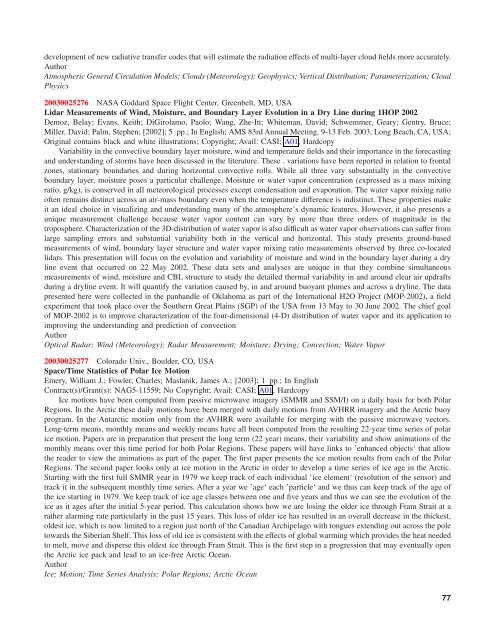You also want an ePaper? Increase the reach of your titles
YUMPU automatically turns print PDFs into web optimized ePapers that Google loves.
development of new radiative transfer codes that will estimate the radiation effects of multi-layer cloud fields more accurately.<br />
Author<br />
Atmospheric General Circulation Models; Clouds (Meteorology); Geophysics; Vertical Distribution; Parameterization; Cloud<br />
Physics<br />
20030025276 NASA Goddard Space Flight Center, Greenbelt, MD, USA<br />
Lidar Measurements of Wind, Moisture, and Boundary Layer Evolution in a Dry Line during 1HOP 2002<br />
Demoz, Belay; Evans, Keith; DiGirolamo, Paolo; Wang, Zhe-In; Whiteman, David; Schwemmer, Geary; Gentry, Bruce;<br />
Miller, David; Palm, Stephen; [2002]; 5 pp.; In English; AMS 83rd Annual Meeting, 9-13 Feb. 2003, Long Beach, CA, USA;<br />
Original contains black and white illustrations; Copyright; Avail: CASI; A01, Hardcopy<br />
Variability in the convective boundary layer moisture, wind and temperature fields and their importance in the forecasting<br />
and understanding of storms have been discussed in the literature. These . variations have been reported in relation to frontal<br />
zones, stationary boundaries and during horizontal convective rolls. While all three vary substantially in the convective<br />
boundary layer, moisture poses a particular challenge. Moisture or water vapor concentration (expressed as a mass mixing<br />
ratio, g/kg), is conserved in all meteorological processes except condensation and evaporation. The water vapor mixing ratio<br />
often remains distinct across an air-mass boundary even when the temperature difference is indistinct. These properties make<br />
it an ideal choice in visualizing and understanding many of the atmosphere’s dynamic features. However, it also presents a<br />
unique measurement challenge because water vapor content can vary by more than three orders of magnitude in the<br />
troposphere. Characterization of the 3D-distribution of water vapor is also difficult as water vapor observations can suffer from<br />
large sampling errors and substantial variability both in the vertical and horizontal. This study presents ground-based<br />
measurements of wind, boundary layer structure and water vapor mixing ratio measurements observed by three co-located<br />
lidars. This presentation will focus on the evolution and variability of moisture and wind in the boundary layer during a dry<br />
line event that occurred on 22 May 2002. These data sets and analyses are unique in that they combine simultaneous<br />
measurements of wind, moisture and CBL structure to study the detailed thermal variability in and around clear air updrafts<br />
during a dryline event. It will quantify the variation caused by, in and around buoyant plumes and across a dryline. The data<br />
presented here were collected in the panhandle of Oklahoma as part of the International H2O Project (MOP-2002), a field<br />
experiment that took place over the Southern Great Plains (SGP) of the USA from 13 May to 30 June 2002. The chief goal<br />
of MOP-2002 is to improve characterization of the four-dimensional (4-D) distribution of water vapor and its application to<br />
improving the understanding and prediction of convection<br />
Author<br />
Optical Radar; Wind (Meteorology); Radar Measurement; Moisture; Drying; Convection; Water Vapor<br />
20030025277 Colorado Univ., Boulder, CO, USA<br />
Space/Time Statistics of Polar Ice Motion<br />
Emery, William J.; Fowler, Charles; Maslanik, James A.; [2003]; 1 pp.; In English<br />
Contract(s)/Grant(s): NAG5-11559; No Copyright; Avail: CASI; A01, Hardcopy<br />
Ice motions have been computed from passive microwave imagery (SMMR and SSM/I) on a daily basis for both Polar<br />
Regions. In the Arctic these daily motions have been merged with daily motions from AVHRR imagery and the Arctic buoy<br />
program. In the Antarctic motion only from the AVHRR were available for merging with the passive microwave vectors.<br />
Long-term means, monthly means and weekly means have all been computed from the resulting 22-year time series of polar<br />
ice motion. Papers are in preparation that present the long term (22 year) means, their variability and show animations of the<br />
monthly means over this time period for both Polar Regions. These papers will have links to ’enhanced objects‘ that allow<br />
the reader to view the animations as part of the paper. The first paper presents the ice motion results from each of the Polar<br />
Regions. The second paper looks only at ice motion in the Arctic in order to develop a time series of ice age in the Arctic.<br />
Starting with the first full SMMR year in 1979 we keep track of each individual ’ice element‘ (resolution of the sensor) and<br />
track it in the subsequent monthly time series. After a year we ’age‘ each ’particle‘ and we thus can keep track of the age of<br />
the ice <strong>star</strong>ting in 1979. We keep track of ice age classes between one and five years and thus we can see the evolution of the<br />
ice as it ages after the initial 5-year period. This calculation shows how we are losing the older ice through Fram Strait at a<br />
rather alarming rate particularly in the past 15 years. This loss of older ice has resulted in an overall decrease in the thickest,<br />
oldest ice, which is now limited to a region just north of the Canadian Archipelago with tongues extending out across the pole<br />
towards the Siberian Shelf. This loss of old ice is consistent with the effects of global warming which provides the heat needed<br />
to melt, move and disperse this oldest ice through Fram Strait. This is the first step in a progression that may eventually open<br />
the Arctic ice pack and lead to an ice-free Arctic Ocean.<br />
Author<br />
Ice; Motion; Time Series Analysis; Polar Regions; Arctic Ocean<br />
77
















